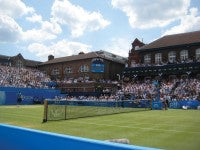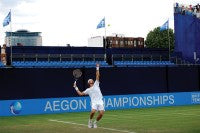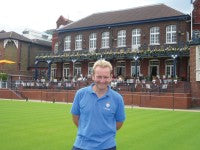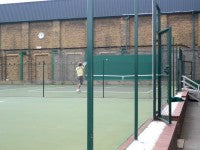The King of Queen's
"In the UK, we have the best courts and the most skilled groundsmen who know how to look after them. We cannot allow such a quality provision to die out"
 London is famed for enjoying one of the richest of all sporting heritages, especially so since the 19th century when the capital bore witness to the formation of many new sports and clubs, to the present era, which is witnessing the birth of a new generation of mega, modern stadia, not to mention the mammoth 2012 Olympic site.
London is famed for enjoying one of the richest of all sporting heritages, especially so since the 19th century when the capital bore witness to the formation of many new sports and clubs, to the present era, which is witnessing the birth of a new generation of mega, modern stadia, not to mention the mammoth 2012 Olympic site.
Whilst work on the Olympics facilities continues apace in the east of London, on the west side, tucked neatly between rows of elegant Edwardian and Victorian town houses along Kensington's affluent residential streets, it's business as usual for, arguably, the second most prestigious lawn tennis hub in the country - The Queen's Club.
Established in 1886, The Queen's Club was formed on the site of what was originally a market garden. The sporting origins stemmed from a group of local businessmen who wanted to form a sports club with a multi-use outlook.
Queen Victoria agreed to be its first patron so, accordingly, the name The Queen's Club was created.
Whilst, today, the club's fame is rooted in lawn tennis and racket sports, over the decades this prime hectarage of London land has seen as many as 25 different sports played here - everything from ice-skating and baseball, to athletics and rugby.
By the late 1920s, annual fixtures included Oxford v Cambridge rugby matches, football ties and athletics, which were staged on the cinder track that once ran around the perimeter of the site. The diversity of sports attracted crowds of more than 10,000 strong, lured by the boom in interest for competitive sport.
As sports such as football, rugby and athletics grew in popularity, The Queen's Club facilities were no match for demand and they were transferred to new homes at Wembley, Twickenham and White City respectively.
Meanwhile, the increasingly popular game of lawn tennis, which had continued to blossom as mowing machinery developed, took over at Queen's as the club embarked on a commitment to produce the highest quality tennis lawns.
 This demand for quality remains as strong today as it ever was. Whilst technology has moved on, and turfcare practices have advanced out of all recognition, the need to maintain the club's impeccable reputation has remained constant - a commitment that Grounds Manager, Graham Kimpton, has known since he was a boy.
This demand for quality remains as strong today as it ever was. Whilst technology has moved on, and turfcare practices have advanced out of all recognition, the need to maintain the club's impeccable reputation has remained constant - a commitment that Grounds Manager, Graham Kimpton, has known since he was a boy.
Taking over the position from his father, David, after working under him for twenty-five years, Graham is the latest in a dynastic line of family members drawn to a career in turfcare.
David began work at Queen's in 1966, and spent forty-three years in the job, passing on the head groundsman's duties to his son on retirement last year, while Graham's uncle was putting in fifty years of service at The Hurlingham Club, his only interruption being a break for national service. "Maybe it explains why I entered the industry," Graham muses. "Groundsmanship is clearly in the blood."
Longevity of service seems a characteristic of the industry but, being immersed in lawn care since childhood and growing up around the club, has clearly been a recipe for success for Graham.
"I've learnt everything I know from my dad. His attention to detail is probably the biggest impact he's had on the way I do things now," he states. "Most importantly, he taught me that we have to do things a certain way here - we have a reputation to uphold."
Graham nearly took a markedly different career path, however. He began an engineering apprenticeship at sixteen only to realise, after a year, that it wasn't the route for him.
He then spent a year travelling Australia before returning to the UK and an invitation from his father to work at Queen's. From then on, Graham knew groundsmanship was the avenue he wished to explore, so enrolled at Norwood Hall Agricultural College to study for an NCT qualification, which he gained in 1995. He has gone on to become an examiner and assessor for the IOG and City and Guilds - an aspect of his job he believes is vitally important for him to stay on top of his game.
 "It's a good thing to know about the exams, especially in this business, as many groundsmen overlook them or think they're not worthwhile," argues Graham. "It keeps you on your toes and up to speed with the latest changes."
"It's a good thing to know about the exams, especially in this business, as many groundsmen overlook them or think they're not worthwhile," argues Graham. "It keeps you on your toes and up to speed with the latest changes."
"Aside from that, it helps to get out of your comfort zone, otherwise it can become easy to simply stick with what you know and what you think is best. It's important to always be pushing, especially in an industry where it's vital to ensure new blood keeps coming in."
Whilst teaching is an adjunct to the main job in hand, this aspect of his work he greatly enjoys and the club hosts frequent day visits from students at Kew Gardens studying the Kew Diploma.
"As part of their course they have to do a turf module, so they come to us seeking advice on how we do things, which I really enjoy. It also gives me the chance to see my old tutor at Norwood Hall, Len Stocks - a man with tremendous knowledge in training who has taught me a great deal over the years."
The club hosts an array of world ranked tournaments, including the Aegon Championships (formerly the Stella Artois Championships), the World Rackets Championships and leading real tennis events (Queen's has two courts), including the British Open and now the Atco Super Series Squash Finals.
Not all of these directly involve Graham - his key responsibility is to maintain the twenty-eight outdoor courts, of which the twelve grass ones are some of the finest anywhere, the spread of different playing surfaces available, including ten indoor tennis courts (six acrylic and four carpet), six acrylic all-weather, six clay and four new artificial grass courts. There's even a short tennis area and a practice wall, where one of the turfcare team was brushing up on his strokes as we toured the club.
 The team's busiest time of year is the run-up to the Aegon Championships, staged straight after the French Open, and the ideal warm-up event on grass before Wimbledon.
The team's busiest time of year is the run-up to the Aegon Championships, staged straight after the French Open, and the ideal warm-up event on grass before Wimbledon.
Signs of the huge transformation that the club undergoes for the event were few and far between. Centre Court, which stages all the event's competitive play, looked lush and ready for action once more - just a month after the event left town.
The week-long championships, two weeks before Wimbledon, has long proved popular with some of the giants of the game, with the likes of Nadal, Hewitt and Roddick winning the event in recent years but, strangely, says Graham, not Federer.
The Grade 1 listed pavilion overlooking the court offers a uniquely intimate involvement with the tournament, where club members and players can interact both before, during and after the game.
"Players often share a drink and a chat in the pavilion, rather than just playing and going," says Graham. "Our members love that, and it's a special element of the event and one that is unknown anywhere except perhaps Monte Carlo and Rhode Island."
Contrasting with the intimacy on the one side of Centre Court is the commercial reality of the game on the other, where temporary seating for some 7,000 spectators looms high above the grass, erected over the neighbouring acrylic court. In all, the club can handle up to 10,000 people a day, so it's no mean feat to accommodate them comfortably amid the glare of the world's media.
"This is a big event for us, and there's a real buzz from the members and my team at being able to get close to some of the world's top players," gleams Graham.
 "You cannot truly appreciate the unbelievably high standard of these players until you see them in action up close, and it's great to witness the world's best tennis played on a surface we have created."
"You cannot truly appreciate the unbelievably high standard of these players until you see them in action up close, and it's great to witness the world's best tennis played on a surface we have created."
The Lawn Tennis Association bought the club from the members back in the 1950s when, in truth, says Graham, "we had seen better days." The LTA established its headquarters there and, from then on, what is now the ATP-ranked annual championships were built up to become the hugely successful commercial undertaking it is today. Delete hosting fee sentence
During its time at Queen's, the LTA invested heavily in a new administrative centre and extensive indoor tennis provision, including the Academy, formed to nurture new talent.
The then Stella Artois Championships, sponsored by the brewers of the lager since 1978, reached a crossroads in 2006 when the LTA sought a sponsor for all its events. In stepped insurance group Aegon, the event was rebranded and the switch coincided with the LTA's decision to sell the club back to the members, in part to fund the development of the National Tennis Centre at Roehampton.
Comparisons with Wimbledon are unavoidable, says Graham, yet he is keen to stress that Queen's runs things slightly differently from its neighbours in SW19, yet still achieves some very impressive outcomes.
"Wimbledon has been active with koroing over the last few years and many lawn tennis clubs around the country have followed its lead," explains Graham. "We've steered clear of such extremes, as we feel that it results in taking away too much of the natural goodness that builds up over the years in the soil."
"When we scarify in the autumn, the soil is still left brown and there's plenty of good nutrients left that help form a sound basis for years to come."
 With a healthy annual budget covering wages for the seven full-time groundstaff, Graham has the freedom to experiment with different grasses to create what he believes is the best balance for lawn tennis.
With a healthy annual budget covering wages for the seven full-time groundstaff, Graham has the freedom to experiment with different grasses to create what he believes is the best balance for lawn tennis.
Currently he uses a 50% ryegrass mix of 25% Bar Gold and 25% Bar Lady, 22.5% slender creeping red fescue, also supplied by Barenbrug, a 22.5% strong creeping red fescue and finally a 5% browntop bent.
"I've found that if you have just ryegrass it gives you too open a sward," he states. "With a mix of ryegrass, red fescues and bent, the more slender fine grasses give the right amount of lateral growth, which fill the spaces in the sward and offer little room for weeds and other unwanted species to grow through. "Fescues are drought resistant due to their origin, so it's good to have a certain percentage of them in there. Ultimately, a good mix of species will give you a better balance."
The system seems to be working well for him. Top tennis pros like Lleyton Hewitt and Andy Roddick recently named The Queen's Club Centre Court the best grass court they'd ever played on. A good number of the club's 4,000 members are equally enthusiastic.
"There's a certain satisfaction that comes with jobs like ours," says Graham. "We toil over the turf to create the best possible surface we can, and it's a great feeling to stand back and look at what we've created - and it's that bit better when you're receiving such positive comments from these big name players."
Support from the top is important though. "My staff and I are well looked after here. The members, directors and chief executive all recognise the need for investment in what is the club's most important asset."
"With big budgets come responsibilities, so there's little room for excuses on our part. With 4,000 members, each paying annual fees of £2,000, and a requirement to buy a share in the club costing £12,000, the members want to have the best facilities to play on. If the lawns aren't top notch, they'll ask us why they're not. Big money rides on our courts being the best around."
The play on grass often lingers on as late as the end of the first week in October, making Queen's one of the longest grass seasons in the country. That, in turn, means a well-planned year-round programme is essential for the courts to remain in top condition for the duration.
"The summer playing season is really a matter of cutting, marking and irrigation. We do little work through the season as it would simply interrupt play too much," Graham explains.
Autumn marks the club's big renovation period, when Graham and his team take on all the jobs needed before winter sets in. "We always aim to leave over some construction and maintenance jobs, like hedge trimming, to the winter months so the guys are always kept busy," he explains. "The key job through the winter is to aerate, usually down to a depth of five inches. We carry out a hollow core aeration programme on a five-yearly basis, which is more than enough for grass courts."
The onset of spring brings with it a bulk of new work in preparation for the Aegon event and the onset of the grass court season. Graham starts rolling in early spring, keeping the weight at between 1.8 and 2 tonnes.
"We have to take care with rolling as our lawns firm up pretty quickly, and it's easy to overroll and undo all the good work that's gone before."
The firmness of The Queen's Club grass courts has been, in no small part, due to the changes wrought by Graham and his father under a commitment to achieve a good bounce.
"We've relaid the courts using Ongar loam on top of the original silty type fen soil laid a century ago. When we relaid the courts, we found there wasn't a high clay content, so we couldn't get it as hard as we wanted, so that prompted the change. Now, there's that extra level of firmness, which makes the world of difference."
The Allett, Lloyds Paladin and Dennis FT510 the team use are all made to a 20" cut width to suit tennis stripes. "It's all about presentation. You never have a white line down the middle of a stripe."
Whilst the grass courts take centre stage throughout the summer season, Queen's offer the spectrum of playing surfaces. The red clay courts are said to be some of the best in the UK, if not Europe, and visiting professionals like to train on them.
The club's six shale/clay courts have been a permanent feature for fifty years, although they are a challenge to maintain successfully, Graham admits. "It's common knowledge that clay courts are difficult to keep right, and few people here really know how to maintain them properly."
"Luckily, my father was one of the best and taught me well. Now, I make sure all my guys know how to set them up, so we can keep alive our tradition of quality clay provision."
Members prize the courts highly and enjoy the variety they offer, despite the affect that the weather can have on them. As water binds the surface together, the courts can freeze over in winter but dry out and crack through the summer months as lack of water creates almost dustbowl conditions. Then, it's a matter of hand watering and nightly irrigation.
The courts at Queen's are laid with the same specification material as those at Roland Garros, host to the French Open,
Both sites are supplied by Simeon Sports - Graham importing the clay annually from quarries in Paris at a cost of £500 a tonne. Relaying of the courts was last completed some 15 years ago. "It was a tough job to complete, taking a whole winter to get right," he recalls. "The most tricky part is the fact that you have to keep them constantly wet, which can be difficult when you're still in the construction phase. The job involved taking the old clay off the top, overlaying the clinker base with graded ash and replacing with the new clay."
The standard of the surface is testament to the craftsmanship of both Graham and his team and his father before him. The courts are good enough to draw French tennis professionals here to practise on them.
The four artificial grass courts, supplied by Doe Sports, laid with new surfaces last August at a total cost of £65,000, is also ensuring the standard of the alternative playing surfaces stays high. And, surprisingly, says Graham, "we get more compliments on the standard of the artificial courts from our members than any other. They will often ask where they can get hold of one for their own garden."
The six outdoor acrylic courts, supplied by Plexipave, offer Graham a far easier maintenance option, with a straightforward resurfacing or recolouring delivering a brand new look, he says.
The indoor provision of six acrylic and four carpeted courts are also heavily used by members and for training juniors, whilst, to boost capacity still further during winter, the club purchased a bubble for fixing over two outdoor courts.
The Queen's Club holds one of the top positions for grass court tennis - Graham is fortunate to be given an enviable budget by any standards, a supportive grounds team and a board of directors that understands the virtues of positive spending to achieve the highest quality surfaces.
Yet, he knows this is a far cry from the state of grass court tennis elsewhere in Britain. "We are lucky here that we would never get rid of the grass courts, as they are the moneyspinners and what attracts our members," he stresses.
"Unfortunately though, most tennis clubs are run on a shoestring, so they see artificial courts as a more viable financial option and end up getting rid of their grass courts, which they can only use for the summer."
"If smaller clubs can make money from teaching the whole year round then they'll go with that. More needs to be done to retain our grass courts. In the UK, we have the best courts and the most skilled groundsmen who know how to look after them. We cannot allow such a quality provision to die out."
